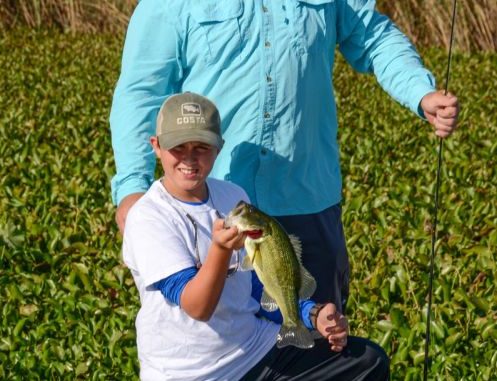
Tony Landry explained why spinnerbaits work.
“They are profile baits that effectively mimic different things that fish eat,” Landry said. “The rubber skirts we use pulse in the water, and the blades also pulse and reflect the flash of food fish.”
Accomplished bass angler Willie Couch III said the lures are reaction baits that fish strike without studying them.
“If you throw a spinnerbait all day long, you’re going to catch something,” Couch promised. “I use spinners 50 percent of the time in tournament fishing. It is effective to go down a bank with a spinner and pick up several fish; then come back and hit the same area with a soft bait to pick up the slower fish that didn’t react.
“Another approach is to have the guy in the front of the boat tossing a spinner to catch numbers of fish and the guy in the back flipping soft plastics to catch larger fish.”
Both men are avid believers in safety pin spinnerbaits. They put their heads together to give their take on the lures’ pluses and minuses.
Pros
• Spinnerbaits can be modified by changing blade colors and sizes to mimic different foods: small shad, large shad, bluegills, or crawfish. South of I-10, colored blades do better — chartreuse, green, red, and orange, rather than the traditional gold or silver.
• Spinnerbaits are great search baits. A lot of water can be covered in a short period of time.
• Spinners excel in windy and stained-water conditions
• Water grasses stymie the use of lures with treble hooks. The arm with the blades makes the lure semi-weedless and they can also be bounced off of stumps.
• They are versatile. They can be reeled faster or slower and combined with raising or lowering the rod tip. As such, they can be made to fish all depths of water.
• Spinners are year-round baits. Jigs are best in spring, frogs in summer, topwaters in late spring and summer, and so forth, but spinners work all year.
• Skirts and blades can be changed on the water. This can be important when a fisherman finds a good combination and loses the only lure in the boat like it. A variety of loose skirts and blades can be carried in a very small space.
• Because spinners have single in-line hooks, fewer hooked fish are lost than with treble-hook lures.
• Spinnerbaits are simple — and good for novices. Basically they are a cast-and-retrieve lure. You don’t have to work them. Landry said his father carries one rigged rod and fishes with only one bait: a blue/white/chartreuse-skirted spinner with double gold or silver and gold blades.
“At the end of the day, he has just as many or more fish than anyone else,” Landry said.
• Spinners are inexpensive, costing half the price of hard baits. The price per pack of soft plastics is about the same as a spinner. An average fisherman will catch more fish on one spinner than on a pack of plastics.
Cons
• With gin-clear water and under calm conditions, natural-colored soft plastics are better than spinners.
• Spinnerbaits cannot penetrate vegetation like a heavy creature bait can. Spinners are limited to fishing the edges of the vegetation.
• For some reason, spinnerbaits tend to hang up in rocks more than crankbaits. Bass also seem to like how crankbaits deflect off rocks. You can’t make a spinner do that.
• The biggest negative is that when bass are sulking, they don’t react as well to a spinner as they do to a slow bait. Spinnerbaits appeal best to aggressive or active fish.
